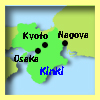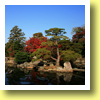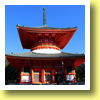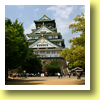Kinki region
 The former capital cities of Japan such as Kyoto, Nara and so on are located in Kinki region ( right ) where the former Imperial Palaces and Villas, old temples and shrines, huge castles and many historic sites are also located ( ==> A History of Japan vol.1 Formation of Japan ). There are many places to visit and many things to see as well as various foods to eat.
The former capital cities of Japan such as Kyoto, Nara and so on are located in Kinki region ( right ) where the former Imperial Palaces and Villas, old temples and shrines, huge castles and many historic sites are also located ( ==> A History of Japan vol.1 Formation of Japan ). There are many places to visit and many things to see as well as various foods to eat.
Kyoto City
 Kyoto City had been the capital city of Japan for more than a thousand years since A.D.794 until Tokyo became the capital city after Tokugawa Shogunate was overthrown in A.D.1868. So there remain Kyoto Gosho ( Kyoto Imperial Palace ), Katsura Rikyu ( Katsura Imperial Villa ), Kinkaku-ji Temple ( Golden Pavilion - right ), Nijo-jo Castle, Ryoan-ji Temple, Fushimi-Inari-Taisha Shrine and many more.
Kyoto City had been the capital city of Japan for more than a thousand years since A.D.794 until Tokyo became the capital city after Tokugawa Shogunate was overthrown in A.D.1868. So there remain Kyoto Gosho ( Kyoto Imperial Palace ), Katsura Rikyu ( Katsura Imperial Villa ), Kinkaku-ji Temple ( Golden Pavilion - right ), Nijo-jo Castle, Ryoan-ji Temple, Fushimi-Inari-Taisha Shrine and many more.
Also tourists could enjoy tasty and beautiful Japanese cuisine in many restaurants and ryokan ( Japanese style accommodation ) in Kyoto, which has been and is the most important platform for the development of Japanese culture and is one of the best cities to experience Japanese Cuisine.
Katsura Rikyu ( Kyoto )
 Katsura Rikyu ( Katsura Imperial Villa - right ), located in the southwest of Kyoto, was built by two imperial princes ( Toshihito Shinno and his son, Toshitada Shinno ) and completed in A.D.1645. In Katsura Rikyu remain the most beautiful Japanese garden as well as the palace and some teahouses. Tourists could walk around the garden and inside some buildings.
Katsura Rikyu ( Katsura Imperial Villa - right ), located in the southwest of Kyoto, was built by two imperial princes ( Toshihito Shinno and his son, Toshitada Shinno ) and completed in A.D.1645. In Katsura Rikyu remain the most beautiful Japanese garden as well as the palace and some teahouses. Tourists could walk around the garden and inside some buildings.
Hiei-zan Enryaku-ji Temple and Sakamoto
 Hiei-zan Enryaku-ji Temple ( right ) is a part of the UNESCO World Heritage Site " Historic Monuments of Ancient Kyoto ", where so many tourists visit. The temple was founded in A.D.788 by Saicho ( Dengyo Daishi ), who was one of the most important and famous Buddhist monks.
Hiei-zan Enryaku-ji Temple ( right ) is a part of the UNESCO World Heritage Site " Historic Monuments of Ancient Kyoto ", where so many tourists visit. The temple was founded in A.D.788 by Saicho ( Dengyo Daishi ), who was one of the most important and famous Buddhist monks.
Hiei-zan Enryaku-ji Temple had been so influential not only spiritually but also politically and militarilly that Nobunaga Oda, the most powerful warlord at the time, attacked the temple in A.D.1571 and most of its structures were burnt down. However the reconstruction of the temple started soon and there are dozens of buildings, some of which are National Treasures and Important Cultural Properties of Japan.
Also many tourists visit Sakamoto town which is located at the eastern foot of Hiei-zan ( Mount Hiei ). There in Sakamoto town are shrines and temples which had been and are related to Hiei-zan Enryaku-ji. Tourists could see dozens of National Treasures and Important Cultural Properties of Japan in the town.
Himeji
 Himeji City is so famous for Himeji-jo Castle ( right ), one of the most beautiful castles in Japan. The castle is one of the designated National Treasures of Japan as well as one of UNESCO World Heritage sites. Also impressive is Engyo-ji Temple on the top of Shosha-zan mountain where some historical movies, including Hollywood movie "The Last Samurai", have been filmed.
Himeji City is so famous for Himeji-jo Castle ( right ), one of the most beautiful castles in Japan. The castle is one of the designated National Treasures of Japan as well as one of UNESCO World Heritage sites. Also impressive is Engyo-ji Temple on the top of Shosha-zan mountain where some historical movies, including Hollywood movie "The Last Samurai", have been filmed.
For further details ==>
Himeji
Koya-san Kongobu-ji Temple
 Koya-san Kongobu-ji Temple, located in Wakayama Prefecture, has been one of the most important and famous temple complexes in Japan since the 9th century. There remain various kinds of temple structures such as Konpon Daito Pagoda ( right ), Kon-do Main Hall, Mie-do Portrait Hall, Dai-mon Gate and many more including National Treasures and Important Cultural Properties of Japan.
Koya-san Kongobu-ji Temple, located in Wakayama Prefecture, has been one of the most important and famous temple complexes in Japan since the 9th century. There remain various kinds of temple structures such as Konpon Daito Pagoda ( right ), Kon-do Main Hall, Mie-do Portrait Hall, Dai-mon Gate and many more including National Treasures and Important Cultural Properties of Japan.
There remain more than 100 temples in the precinct, more than 50 of which offer temple lodging. Tourists, staying in such temples ( Shukubo ) could experience shojin ryori ( vegetarian Buddhist cuisine ), morning prayers, sutra copying and so on.
Koya-san Kongobu-ji Temple is included in UNESCO World Heritage Site "Sacred Sites and Pilgrimage Routes in the Kii Mountain Range".
Kumano Sanzan and Kumano Kodo
 For more than 1,000 years, so many people have walked along Kumano Kodo ( Kumano ancient paths - right ) to visit Kumano Sanzan area where three Kumano Taisha ( Kumano Grand Shrines ) are located. Even some Retired Emperors had walked a few hundred kilometers from Kyoto to Kumano which is located in the south of Kinki region.
For more than 1,000 years, so many people have walked along Kumano Kodo ( Kumano ancient paths - right ) to visit Kumano Sanzan area where three Kumano Taisha ( Kumano Grand Shrines ) are located. Even some Retired Emperors had walked a few hundred kilometers from Kyoto to Kumano which is located in the south of Kinki region.
UNESCO World Heritage Site "The Sacred Sites and Pilgrimage Routes in Kii Mountain Range" consists of Kumano Sanzan, Kumano Kodo and some more. Kumano area is also rich in nature.
Osaka
 In the 4-6th centuries, Osaka developed as an important international port. In the 7-8th canturies, the Imperial Palaces were located in Osaka. In A.D.1583 the construction of Osaka-jo Castle ( right ) was started by Hideyoshi Toyotomi who unified Japan after Sengoku Jidai ( Age of Warring States ==> A History of Japan vol.2 Samurai Age ).
In the 4-6th centuries, Osaka developed as an important international port. In the 7-8th canturies, the Imperial Palaces were located in Osaka. In A.D.1583 the construction of Osaka-jo Castle ( right ) was started by Hideyoshi Toyotomi who unified Japan after Sengoku Jidai ( Age of Warring States ==> A History of Japan vol.2 Samurai Age ).
Even after Ieyasu Tokugawa established Tokugawa Shogunate in Edo ( Tokyo now ) in A.D.1603, Osaka has been an important business city. Such history made Osaka a unique city in Japan.
Now there are many popular sites in Oasaka including a large castle and old shrines. Also it is said that Osaka is a town of "Kuidaore" ( "Eat until you drop" ). Tourits could experience the unique local food culture in Osaka, the third largest city and the center of the second largest metropolitan area in Japan.
For further details ==>
Osaka
|